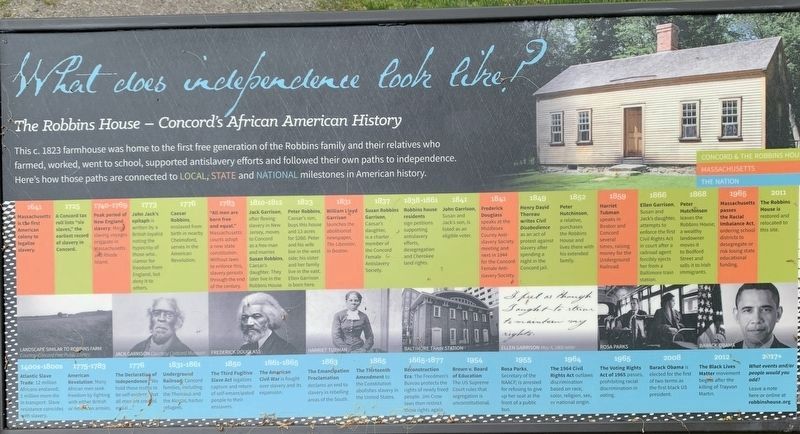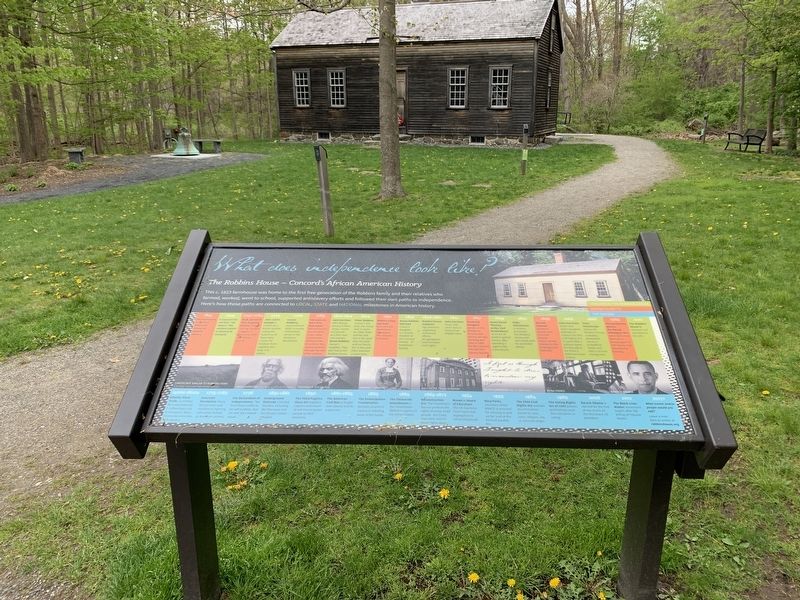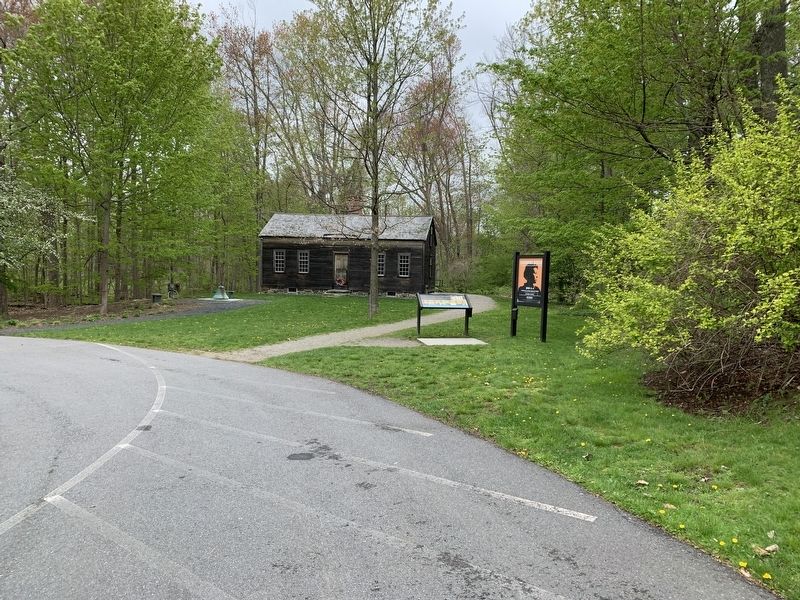Concord in Middlesex County, Massachusetts — The American Northeast (New England)
The Robbins House
Concord’s African American History
— What Does Independence Look Like? —
This c. 1823 farmhouse was home to the first free generations of the Robbins family and their relatives who farmed, worked, went to school, supported anti-slavery efforts, and followed their own paths to independence. Here’s how those paths are connected to local, state, and national milestones in American history.
Robbins’ Timeline (green squares):
1725 -- A Concord tax roll lists “six slaves,” the earliest record of slavery in Concord.
1773 – John Jack’s epitaph is written by a British loyalist noting the hypocrisy of those who clamor for freedom from England, but deny it to others.
1776 – Caesar Robbins enslaved from birth in nearby Chelmsford, serves in the American Revolution.
1810-1812 – Jack Garrison, after fleeing slavery in New Jersey, moves to Concord as a free man and marries Susan Robbins, Caesar’s daughter. They later live in the Robbins House.
1823 – Peter Robbins, Caesar’s son, buys this house and 13 acres for $260. Peter and his wife live in the west side; his sister and her family live in the east side. Ellen Garrison is born here.
1837 Susan Robbins Garrison, Caesar’s daughter, is a charter member of the Concord Female Antislavery Society.
1838 – 1861 Robbins house residents sign petitions supporting antislavery efforts, desegregation and Cherokee land rights.
1841 – John Garrison, Susan and Jack’s son, is listed as an eligible voter
1849 – Henry David Thoreau writes Civil Disobedience as an act of protest against slavery after spending a night in the Concord jail.
1852 – Peter Hutchinson, a relative, purchases the Robbins House and lives there with his extended family.
1866 – Ellen Garrison, Susan and Jack’s daughter attempts to enforce the first Civil Rights Act in court after a railroad agent forcibly ejects her from a Baltimore train station.
1868 – Peter Hutchinson leaves the Robbins House, a wealthy landowner moves it to Bedford Street and sells it to Irish immigrants
2011 – The Robbins house is restored and relocated to this site.
Massachusetts Timeline (orange squares):
1641 – Massachusetts is the first American colony to legalize slavery
1740 – 1769 – Peak period of New England slavery: most slaving voyages originate in Massachusetts and Rhode Island.
1783 – “All men are born free and equal.” Massachusetts’s courts adopt a new state constitution. Without laws to enforce this, slavery persists through the end of the century.
1831 – William Lloyd Garrison launches the abolitionist newspaper, The Liberator, in Boston.
1841 – Frederick Douglass speaks at the Middlesex County Antislavery Society meeting and next in 1844 for the Concord Female Antislavery Society.
1859 – Harriet Tubman speaks in Boston and Concord several times, raising money for the Underground Railroad.
1965 – Massachusetts passes the Racial Imbalance Act, ordering school districts to desegregate or risk losing state educational funding.
National Timeline (blue squares):
1400s – 1800s Atlantic Slave Trade: 12 million Africans enslaved; 2 million more die in transports. Slave resistance coincides with slavery.
1775 – 1783 American Revolution. Many African men seek freedom by fighting with either British or American Armies.
1776 – The Declaration of Independence: “We hold these truths to be self-evident, that all men are created equal…”
1831-1861 Underground Railroad: Concord families, including the Thoreaus and the Alcotts, harbor refugees.
1859 – The Third Fugitive Slave Act legalizes capture and return of self-emancipated people to their enslavers.
1861-1865 The American Civil War is fought over slavery and its expansion.
1863 The Emancipation Proclamation declares an end to slavery in the rebelling areas of the South.
1865 The Thirteenth Amendment to the Constitution abolishes slavery in the United States.
1865-1877 Reconstruction Era: The Freedmen’s Bureau protects the rights of newly freed people. Jim Crow laws then restrict these rights again.
1954 Brown v. Board of Education: US Supreme Court rules segregation is unconstitutional.
1955 Rosa Parks, secretary of the NAACP, is arrested for refusing to give up her seat at the front of a public bus.
1964 The 1964 Civil Rights Act outlaws discrimination based on race, color, religion, sex or national origin.
1965 The Voting Rights Act of 1965 passes, prohibiting racial discrimination in voting.
2008 Barrack Obama is elected for the first of two terms as the first black US president.
2012 The Black Lives Matter movement begins after the killing of Trayvon Martin
2017+ What events and/or people would you add? Leave a note here or online at robbinshouse.org
Topics. This historical marker is listed in these topic lists: Abolition & Underground RR • African Americans. A significant historical year for this entry is 1823.
Location. 42° 28.199′ N, 71° 20.889′ W. Marker is in Concord, Massachusetts, in Middlesex County. Marker is on Monument Street north of Great Meadow Road, on the right when traveling north. Marker is in the parking area for "The North Bridge" trail. Touch for map. Marker is at or near this postal address: 320 Monument Street, Concord MA 01742, United States of America. Touch for directions.
Other nearby markers. At least 8 other markers are within walking distance of this marker. The North Bridge (about 300 feet away, measured in a direct line); The Old Manse (about 600 feet away); Concord Battle Monument (about 600 feet away); Concord Fight (about 600 feet away); Grave of British Soldiers (about 700 feet away); The Minuteman of Concord 1775 (approx. 0.2 miles away); Captain Isaac Davis (approx. 0.2 miles away); Two Revolutions (approx. ¼ mile away). Touch for a list and map of all markers in Concord.
More about this marker. The marker has three timeline showing significant events for the Robbins (Concord), Massachusetts, and the United States to indicate how the three "paths" crossed in time in the fight against slavery and for civil rights.
Also see . . . The Robbins House. (Submitted on May 19, 2023, by Michael Herrick of Southbury, Connecticut.)
Credits. This page was last revised on May 19, 2023. It was originally submitted on May 18, 2023, by Steve Stoessel of Niskayuna, New York. This page has been viewed 64 times since then and 13 times this year. Photos: 1, 2, 3. submitted on May 18, 2023, by Steve Stoessel of Niskayuna, New York. • Michael Herrick was the editor who published this page.


